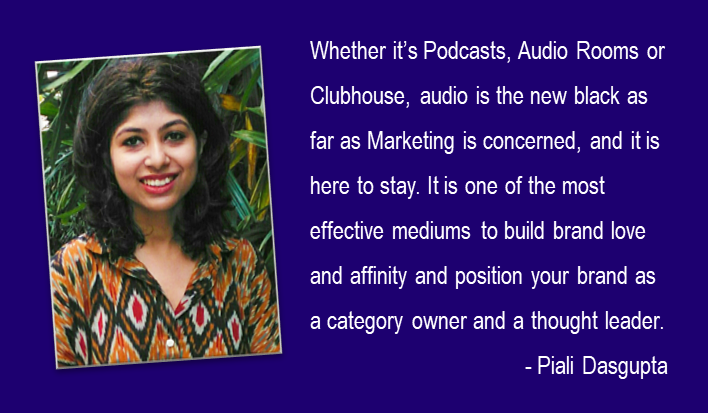At a time when the three seconds of a consumer’s attention is being counted as a “view” by Instagram and Facebook, and the average attention span of a human being is officially less than that of a goldfish, brands are struggling to gain and retain the attention of consumers.
Enter a medium that is a great antidote to the attention economy.
The audio medium.
The great advantage
The great advantage of audio is that it is considered a less intrusive medium than video. Because audio content is something you can consume while going about your daily life. Most podcasts are listened to while driving, walking the dog, or running an errand. So, people do not mind engaging with the medium for even as long as 60 minutes, provided the content is interesting and adds value to their lives.
Most audio platforms are born during the pandemic, which ushered in several lifestyle and habit changes. Given the work-from-home induced excessive screen time and the resultant screen fatigue, the audio medium was a welcome change.
The audio boom
Clubhouse was launched in April 2020, soon after the pandemic hit the world. In India, the app crossed over 5 million downloads in July 2021, just within two months of its launch, accounting for over 80% of its downloads globally.
The number of users did plateau after that, however, quite a few brands such as Tata Cliq and news portals such as The Economic Times use the platform to host debates and discussions regularly.
You know a medium is here to stay when Facebook announces its interest in it. In June 2021, Facebook rolled out Audio Rooms, enabling users to listen to public figures and creators.
Audio Rooms have not gained the sort of traction that Clubhouse did, but brands do have the opportunity to collaborate with creators to create branded content on this platform that allows audio content for upto 8 hours.
In the same month, Spotify also launched Greenroom, its version of Clubhouse, where users can join live discussions or host their own sessions. The app also allows creators to convert live sessions into a podcast, given its integration with Spotify.
Pod it!
While podcasts have existed since 2004, it started gaining traction in India and around the world around 2019. According to PricewaterhouseCoopers’ Media and Entertainment Outlook 2020 report, India is the third-largest podcast listening nation after China and the US with 57.6 million listeners.
Globally, several brands jumped on the podcast bandwagon a few years ago, but could not really sustain in. Examples of these include Sephora, which had a podcast called #LipstickStories that hosted inspiring women and their beauty stories. But the brand discontinued it post September 2019. And ebay’s branded podcast Open for Business, which was all about creating a business from scratch, didn’t add any episodes post April 2017. Microsoft too released only six episodes of its podcast “.future” from June to August 2017.
So what is it that make such huge brands with endless resources discontinue their podcasts?
The flip side
The truth is, while podcasts have many advantages such as undivided user attention, low production costs and present a unique opportunity to tell a brand’s story, the production process of a podcast is fairly time consuming and laborious, something a lot of Marketing teams are unable to deal with. The editing and post-production of a podcast is tedious, and if it’s an interview-led podcast, it does need a lot of groundwork and preparation as well.
Which is why, some of the Indian media brands such as Mad Over Marketing and Moneycontrol have chosen to create pocket-sized, snackable podcast content that are high on frequency, thereby amplifying engagement and gaining listenership.
The latter, in fact, releases an episode almost every day, on all things finance, investment and banking, building thought leadership and authority in the domain with their short-format audio content that ranges between 4 and 25 minutes.
Other than the time-consuming production issue, audio is not the most inclusive medium in a country where 6.3% of the population is hearing impaired.
The voice is the future
According to the BBC, branded podcasts do wonders to all key brand KPIs. They lift brand awareness by 89%, brand favourability by 24%, brand consideration by 57%, and purchase intent by 14%. Many B2B brands such as Intel advertise on podcasts because as per studies, consumers tend to pay a lot more attention to audio ads than video ads.
Whether it’s podcasts, Audio Rooms or Clubhouse, audio is the new black as far as Marketing is concerned, and it is here to stay. Why? Because it is one of the most effective mediums to build brand love and affinity and position your brand as a category owner and a thought leader.
2022, therefore, will be the air of the audio.
The views and opinions published here belong to the author and do not necessarily reflect the views and opinions of the publisher.



Leave a comment